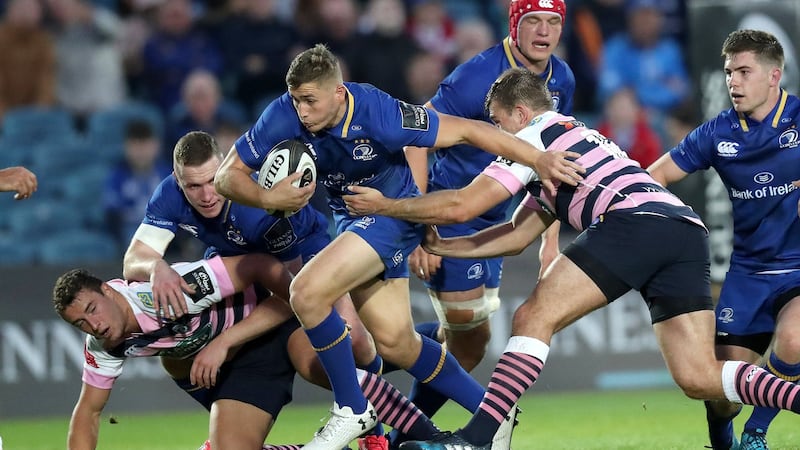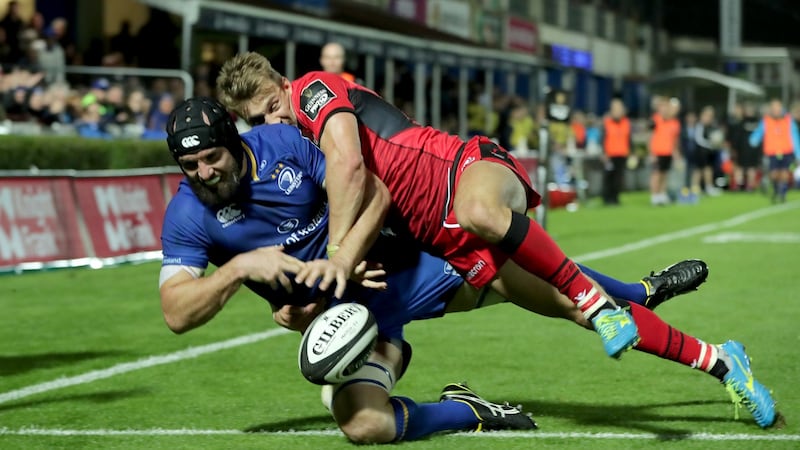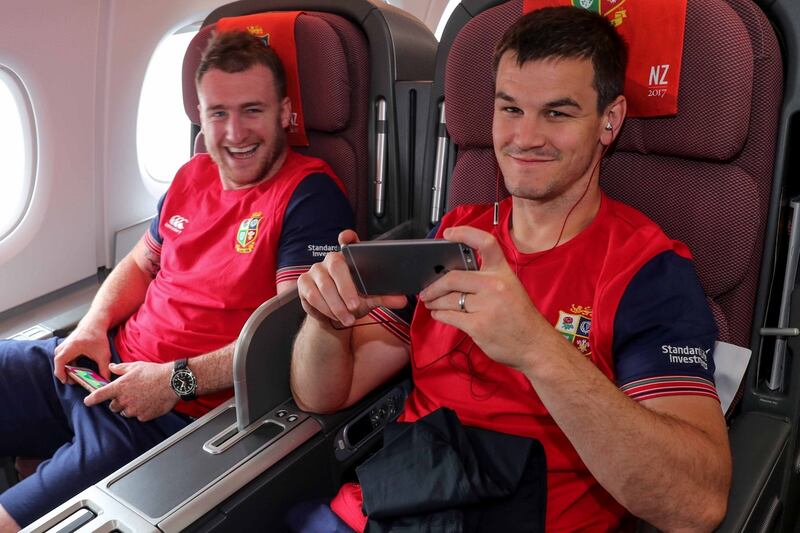I used to be Jordan Larmour. A talented teenager physically able for the men's game. The difference between now and back then is Larmour seemed mentally equipped to evade pitfalls that should come with a plaque bearing my face beside them.
These days young players like Larmour, who just turned 20, and Joey Carbery are leashed for a little longer. I agreed not to tour South Africa in 1998 (as it clashed with the Leaving Cert), but I literally dashed into the professional ranks because of raw ability but also because the ranks weren’t really professional.
I landed in the midst of an ancient drinking culture. When men were men and pre-seasons were hazy bonding sessions, when you hit the gym to bulk up. Not a rugby ball in spitting distance until the nights shortened.
Michael Cheika completely changed all that. Cheiks put some shape on us, slimming us into more mobile athletes to ensure we could cope with the modern game.
By then I was fully on board as a Pro. But the public reputation I chiselled out for myself took an age to erase. Sometimes my peers perhaps believed I lacked the necessary lifestyle to have a career that lasted into double figure seasons.
The blue streaked hair, an eagerness to socialise and getting “Gordon D’Arcy” embroidered on my boots, understandably, lingered in their memory.
Those days are long gone. We built a lasting culture at Leinster. But the Larmours and Carberys of this new era, players who seem primed – with a dollop of good fortune – for serious Test match careers will someday turn 35 and need to find completely different jobs.
That is a scary, unavoidable fact about the life they have chosen. I wish I knew what I know now when I was Jordan Larmour.
Icarus effect
Even if I did, it might not have made any difference. What goes up must come down. The Icarus effect is very, very real for athletes. The first generation of professional rugby players on this island are learning that the hard way. Some get lucky, but most of must us learn through good and bad experiences.

Last Friday I went back to the RDS for the first time. As a civilian. Well, it was the second time. About two years ago I abandoned ship before half-time.
My friend just became a father and he wanted to wet the baby’s head before, during and after Leinster v Edinburgh. I pulled a woolly hat over my ceann and slipped into the stand seconds before kick-off. Just another thirty-something following his team.
Weird night. I wonder if anyone recognises me? And, if so, will they be ear-wigging my every word. Better keep quiet, just in case. The place has changed, different sounds, different perspective I guess, but it was also the same.
Let me try to explain. For just over two years since I took the blue jersey off that last time I am no longer what I have been since the age of 13. A rugby player. No longer working to detailed schedules: be here, there or wherever at an exact time and knowing precisely what to wear at every given moment.
All I really needed to remember from age 18 to 35 was to bring my boots. Everything else was organised for me. One job: Show up in the right frame of mind and perform. Then recover. Then train. Eat, sleep, play, repeat.
The simple life. The good life.
Not even remotely like real life. I’ve been catching up ever since. It’s been an interesting two years and I eventually hope to share some of my insights in this column.
For now, I’ll keep writing about small steps into the real world, a place where everyone I know has had to enter, some as early as their teenage years, others after studies and travels but everyone has had to do it. I’m 15, 20 years behind them in so many ways.
Not too many of the skills I developed as a two-time Lions tourists, 83 Test match veteran and a three-time European champion are as transferable to the corporate world as I had been led to believe.
Protective cloak
Anyway, Friday was the first time I was at the RDS without the protective cloak of a microphone or an ex-players function.
There was an innate feeling of, “should I be here?” Almost feeling like an imposter who would be found out at any moment.
Suffice to say, I felt like I didn’t belong in the one environment that used to provide sanctuary, a place I could go to escape any problem. Partly it was because I couldn’t fix the problems I saw unfolding on the pitch. When Larmour came on for Noel Reid I couldn’t help Ferg or Dave or Johnny by bringing some composure to midfield. I know why – I’m retired. But it still bugged me.
Forging a new identity is an entirely different experience to being a rugby player
For 17 winters Friday night at the RDS/Donnybrook used to be the crescendo of my weekly existence. This is the third autumn I have been processing life without a rugby ball glued under my arm. Perhaps my previous identity was taken for granted. Forging a new identity is an entirely different experience to being a rugby player.
Still, something Les Kiss said to me also rings true. One of his kids recently figured out that Les is not just a coach and his Dad. Once upon a time he scored a try on debut for Queensland in the State of Origin. They could dig up the YouTube clip from 1986 and watch it together.
“I never knew you did this Dad.”
“Why not?”
“Because there is no memorabilia around the house!”
Players leave the game and sometimes think it wise to bury all their medals and jerseys so they can become the person who carries on for the other 50-odd years.
I'm glad I lost the negotiation about displaying some evidence to prove my past life happened. That it's so stylishly done is thanks to Aoife. It's enough to start a conversation or more importantly answer any questions the kids might have some day. There is one picture on the stairs of the time I twisted over for the try against France and the lads trampled over Dusautoir, Fritz and Kayser to drag me up off the grass. There is a story behind my big happy head that they can tell people about because now it is etched into their childhood.
Unsuccessful surgeries
Back in those dark injury cursed days I was forced to plan past rugby. A year out of the game, multiple unsuccessful surgeries, compelled Fintan Drury, my agent and friend, to prepare me for the afterlife.
But there is nothing a player can do to really prepare for how they will feel when it ends. That reality is so alien.
For 24 years I knew precisely what I needed to be doing, with a printed out schedule guiding me from morning to night
I was fully institutionalised, landing into a Clongowes dormitory age 12. Countless bells from 8.50am to 3.40pm told us where to be and what to be wearing. After the summer of ’98 I shifted into Leinster life. Not much changed.
For 24 years I knew precisely what I needed to be doing, with a printed out schedule guiding me from morning to night.
Then it ends and you are left to your own devices. You get a job, swapping one set of virtues for new rules and compliance. The challenges are incredible, deeply unfamiliar and at times a little disconcerting but you begin to adapt, you find resolutions.

So, yes, I still miss the team environment. This past Monday morning in particular. Leinster won but with Munster on the horizon I would have been anxious about the performance. At least the intent was there.
There are plenty of opinions about whether Leinster v Munster is actually the worst preparation for Europe because you can think of nothing else in the build up. That is true but in a lot of ways as players, you don’t have to worry about the following week. Strategy and planning is done on the first floor at Leinster HQ.
I always loved playing them and it hardens you for the French examination that follows.
Flipping the page
The season is alive now. The four Lions returned against Edinburgh, looking unfamiliar at times with the rhythms of those around them. Again, that’s normal and can be fixed very quickly. If not Leinster will be flipping the page to see a monstrous Montpelier thundering towards them. A squad that has gone to another level since last season. Ruan Pienaar, Aaron Cruden and Louis Picamoles being just three additions to an already awesome collection of Springboks – that’s where they are all hiding – and Nemani Nadolo.
Still, I saw plenty to encourage me on Friday night. It wasn't all head wetting. I thought, intercept pass aside, Johnny looked smooth, and that alone should deliver a strong Leinster performance. His tactical kicking and game management remain the best in the game. Scott Fardy seems primed to make a sustained impact. Jack Conan and Josh van der Flier returning with Seánie at six or seven and Jordi or Rhys losing out makes for a serious contest against two of the probable starting Ireland backrow in Peter O'Mahony and CJ Stander.
Despite Friday’s evidence to the contrary, Leinster look in better shape than Munster. I hope I’m not being institutionally biased!
It’s just that I can see the new generation of cultural architects in Leinster. Luke McGrath is one. Larmour even, he is certainly a product of the place (helps that he doesn’t have blue hair and isn’t a stone overweight).
Besides O'Mahony and Stander, obviously, I wonder who will drive all the small yet essential structures Rassie Erasmus has put in place when he and Jacques Nienaber return to South Africa?
I wonder how Munster will cope with all of that.
All told, it makes for a very interesting Saturday afternoon at the Aviva. One that captures the imagination regardless of impending French threats.














